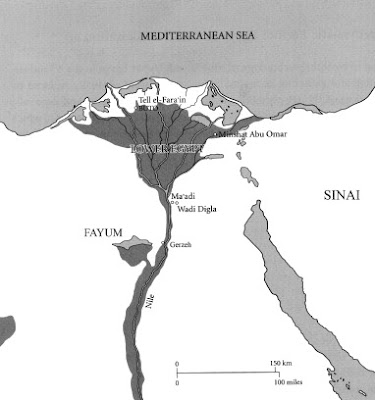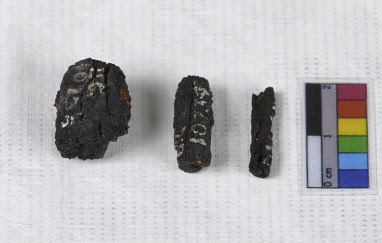Earliest known iron artefacts come from outer space
I ricercatori hanno dimostrato che le antiche 'perle' di ferro in monili Egizi che si trovano presso il Museo Petrie della UCL (University College, London) furono ottenute per martellamento da pezzi di meteoriti, piuttosto che da vene marziali della Terra. Si tratta di oggetti che provengono dallo spazio e che cronologicamente precedono di almeno due millenni la capacità umana di fondere il ferro.
Researchers have shown that ancient Egyptian iron beads held at the UCL Petrie Museum were hammered from pieces of meteorites, rather than iron ore. The objects, which trace their origins to outer space, also predate the emergence of iron smelting by two millennia.
Il ferro fu martellato con cura fino ad ottenerne sottili lamine per poi avvolgerle in tubi sottili, appunto le nove 'perle' - vecchie più di 5000 anni - che furono infilate in una collana insieme con altri minerali preziosi quali l'oro e gemme varie, tutte considerate allora di enorme valore. Lo studio è pubblicato nel Journal of Archaeological Science.
Il ferro fu martellato con cura fino ad ottenerne sottili lamine per poi avvolgerle in tubi sottili, appunto le nove 'perle' - vecchie più di 5000 anni - che furono infilate in una collana insieme con altri minerali preziosi quali l'oro e gemme varie, tutte considerate allora di enorme valore. Lo studio è pubblicato nel Journal of Archaeological Science.
Carefully hammered into thin sheets before being rolled into tubes, the nine beads – which are over 5000 years-old - were originally strung into a necklace together with other exotic minerals such as gold and gemstones, revealing the high value of this exotic material in ancient times. The study is published in the Journal of Archaeological Science.
Il prof. Thilo Rehen (University College London, facoltà di Archeologia, Qatar), primo autore della pubblicazione, sostiene che la metodica usata per il ferro siderale fu ben diversa da quella classica. Quest'ultima, usata comunemente per le pietre e consistente nell'incisione e nella trapanazione, fu impiegata sulle altre perle reperite nella stessa tomba ottenute a partire da gemme.
Il prof. Thilo Rehen (University College London, facoltà di Archeologia, Qatar), primo autore della pubblicazione, sostiene che la metodica usata per il ferro siderale fu ben diversa da quella classica. Quest'ultima, usata comunemente per le pietre e consistente nell'incisione e nella trapanazione, fu impiegata sulle altre perle reperite nella stessa tomba ottenute a partire da gemme.
Professor Thilo Rehren (UCL Archaeology, Qatar), lead author of the paper, said: “The shape of the beads was obtained by smithing and rolling, most likely involving multiple cycles of hammering, and not by the traditional stone-working techniques such as carving or drilling which were used for the other beads found in the same tomb.”
I risultati ottenuti dall'equipe mostrano che nel IV millennio a.C. i lavoratori del metallo erano già padroni delle tecniche di trattamento del ferro meteorico, oltre che della lega ferro nichel (di sicura provenienza spaziale), molto più dura e fragile del semplice rame. Si tratta di tecniche che sarebbero andate a definire l'epoca storica successiva, del Ferro.
I risultati ottenuti dall'equipe mostrano che nel IV millennio a.C. i lavoratori del metallo erano già padroni delle tecniche di trattamento del ferro meteorico, oltre che della lega ferro nichel (di sicura provenienza spaziale), molto più dura e fragile del semplice rame. Si tratta di tecniche che sarebbero andate a definire l'epoca storica successiva, del Ferro.
The team’s results show that in the fourth millennium BC metalworkers had already mastered the smithing of meteoritic iron, an iron-nickel alloy much harder and more brittle than the more commonly worked copper, developing techniques that went on to define the iron age.
Come conseguenza, i lavoratori del metallo egizi avevano già accumulato duemila anni d'esperienza grazie alla lavorazione del ferro meteorico, quando fu disponibile in scala più ampia il materiale ferroso terrestre estratto dalle miniere e fu introdotta la fusione nel II millennio a.C. Questa esperienza divenne certamente preziosa ed essenziale e permise di ottenere ferro dalle miniere e - quando fu necessario - di sostituire il rame ed bronzo con il ferro.
Come conseguenza, i lavoratori del metallo egizi avevano già accumulato duemila anni d'esperienza grazie alla lavorazione del ferro meteorico, quando fu disponibile in scala più ampia il materiale ferroso terrestre estratto dalle miniere e fu introdotta la fusione nel II millennio a.C. Questa esperienza divenne certamente preziosa ed essenziale e permise di ottenere ferro dalle miniere e - quando fu necessario - di sostituire il rame ed bronzo con il ferro.
As a result metalworkers had already nearly two millennia of experience of working with meteoritic iron when iron smelting was introduced in the mid-second millennium BC. This knowledge was essential for the development of iron smelting and the production of iron from iron ore, enabling iron to replace copper and bronze as the main metals used.
Le perle, frutto di uno scavo archeologico del 1911 in un cimitero predinastico presso il villaggio di El-Gerzeh, nel Basso Egitto (Est del Nilo all'altezza del Fayum), erano già completamente corrose quando furono trovate. Di conseguenza, si sono dovute usare radiografie per stabilire se fossero realmente di ferro meteorico o di magnetite terrestre (che può spesso essere confusa col ferro, per le sue proprietà simili).
Le perle, frutto di uno scavo archeologico del 1911 in un cimitero predinastico presso il villaggio di El-Gerzeh, nel Basso Egitto (Est del Nilo all'altezza del Fayum), erano già completamente corrose quando furono trovate. Di conseguenza, si sono dovute usare radiografie per stabilire se fossero realmente di ferro meteorico o di magnetite terrestre (che può spesso essere confusa col ferro, per le sue proprietà simili).
Excavated in 1911, in a pre-dynastic cemetery near the village of el-Gerzeh in Lower Egypt, the beads were already completely corroded when they were discovered. As a result, the team used x-ray methods to determine whether the beads were actually meteoric iron, and not magnetite, which can often be mistaken to be corroded iron due to similar properties.
A mezzo di scansioni con raggi di neutroni e raggi gamma, si sono potute dimostrare sia la tessitura unica, sia la presenza in elevata concentrazione di nichel, cobalto, fosforo e germanio (presenti solamente in tracce nel ferro terrestre) che sono tutte caratteristiche esclusive del ferro meteorico, senza dovere tentare analisi invasive che deteriorassero i rari e preziosi reperti.
A mezzo di scansioni con raggi di neutroni e raggi gamma, si sono potute dimostrare sia la tessitura unica, sia la presenza in elevata concentrazione di nichel, cobalto, fosforo e germanio (presenti solamente in tracce nel ferro terrestre) che sono tutte caratteristiche esclusive del ferro meteorico, senza dovere tentare analisi invasive che deteriorassero i rari e preziosi reperti.
By scanning the beads with beam of neutrons and gamma-rays, the team were able to reveal the unique texture and also high concentration of nickel, cobalt, phosphorous and germanium – which is only found in trace amounts in iron derived from ore - that is characteristics of meteoric iron, without having to attempt invasive analysis which could potentially damage these rare objects.
Il prof Rehen si è dichiarato entusiasta degli ottimi esiti conclusivi della ricerca - effettuata per la prima volta - che ha dimostrato senza ogni dubbio tracce di elementi chiaramente e solamente siderali nei reperti. Inoltre è entusiasta della definitiva dimostrazione di un uso così antico di una tecnica così sofisticata per l'epoca con una materia metallica così difficile da trattare.
 |
| Confronto tra immagine radiografica e fotografica dei reperti (perle egizie di ferro meteorico) |
 |
| Indicazione della località di El Gerzeh |
 |
| Tre delle nove perle del monile Egizio, con le loro dimensioni. |
 |
| Visione trasfersa e frontale di tre perle, da cui si evince la metodica di fabbricazione. |
Il prof Rehen si è dichiarato entusiasta degli ottimi esiti conclusivi della ricerca - effettuata per la prima volta - che ha dimostrato senza ogni dubbio tracce di elementi chiaramente e solamente siderali nei reperti. Inoltre è entusiasta della definitiva dimostrazione di un uso così antico di una tecnica così sofisticata per l'epoca con una materia metallica così difficile da trattare.
Professor Rehren said: “The really exciting outcome of this research is that we were for the first time able to demonstrate conclusively that there are typical trace elements such as cobalt and germanium present in these beads, at levels that only occur in meteoritic iron.
“We are also excited to be able to see the internal structure of the beads, revealing how they were rolled and hammered into form. This is very different technology from the usual stone bead drilling, and shows quite an advanced understanding of how the metal smiths worked this rather difficult material.”
Source: University College London [August 19, 2013]
“We are also excited to be able to see the internal structure of the beads, revealing how they were rolled and hammered into form. This is very different technology from the usual stone bead drilling, and shows quite an advanced understanding of how the metal smiths worked this rather difficult material.”
Source: University College London [August 19, 2013]

